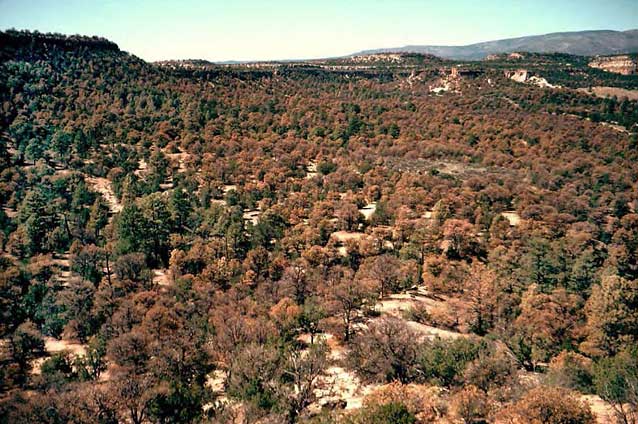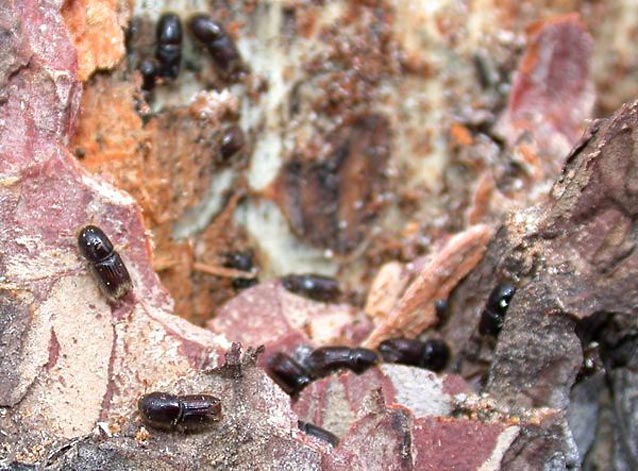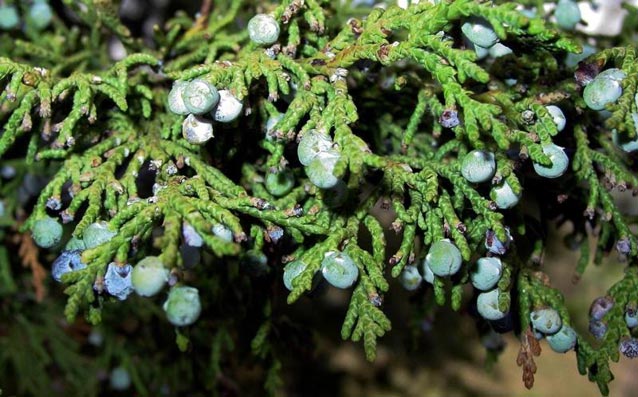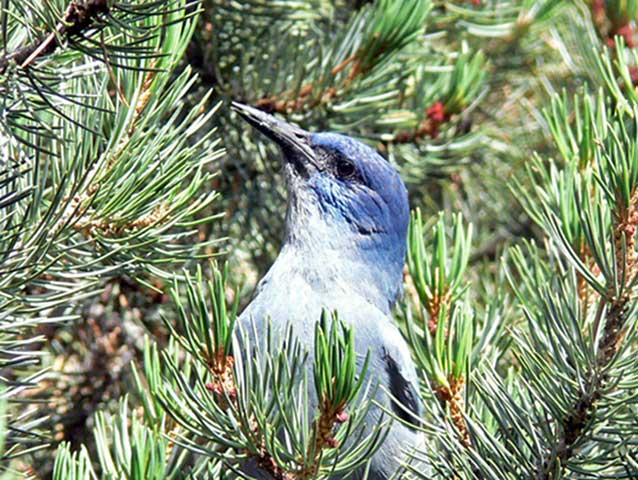Expansions and contractions of pinyon-juniper habitat can be driven by factors, or combinations of factors, such as climate, insects, disease and fire frequency. Climate and fire also influence pinyon pine and juniper succession, since certain conditions are better than others for seed germination and seedling establishment.
Ecosystem Drivers and Disturbance Processes
Climate and drought
Moisture availability and temperature are important factors influencing the expansion and decline of pinyon-juniper woodlands. Surges of pinyon pine and juniper seedling recruitment and growth generally correspond with periods of wet climatic conditions, creating higher-density stands with greater fuel continuity. Subsequent periods of drought create conditions conducive to large, stand-replacing fires. One of the most severe droughts of the 20th century occurred between 1950 and 1956 in the southwestern United States and Mexico, causing massive die-off of many types of drought-adapted vegetation, including conifers, grasses, and cacti (Betancourt et al. 1996). Two decades of higher precipitation, followed by drought, and combined with high winds have fueled six large fires in Mesa Verde National Park since 1996 (Floyd et al. 2004).
Periods of extreme drought intensify a number of other disturbance processes and ecological effects. Shaw et al. (2005) attribute a recent increase in pinyon mortality across portions of the Southwest to “a complex of drought, insects, and disease”—the cumulative effects of multiple mortality agents working in concert.

Photo by Craig D. Allen, USGS.
Endemic insects and disease
Pinyon pines that are affected by moisture stress are more susceptible to outbreaks of disease, parasitism by pinyon dwarf mistletoe (Arceuthobium divaricatum), and damage from endemic insects which feed on cones, needles, shoots, roots, and conductive tissue. Bark beetle and other insect outbreaks are closely tied to drought-induced moisture stress (Allen and Breshears 1998). Populations of pinyon tip moth (Dioryctria albovitella), pinyon cone moth (Eucosma bobana), pinyon Ips (Ips confusus), pinyon twig beetles (Pityophthorus spp. and Pityogenes spp.), pinyon needle scale (Matsucoccus acalyptus), and pinyon needle miner (Coleotechnites edulicola), normally present in pinyon-juniper woodlands at low levels, can increase dramatically during periods of drought, causing large-scale defoliation, reduced growth and reproduction, tree mortality, and a myriad of other effects. Although pinyon Ips beetles usually attack only trees which are already weakened by other agents, they are responsible for the majority of pinyon mortality in the drought-stricken western U.S. Juniper is similarly affected by insects and pathogens, including twig beetles (Phloeosinus spp.), twig pruners (Stylox bicolor), western cedar borer (Trachykele blondeli), and branch-girdling rusts (Gymnosporangium spp.). Juniper is also parasitized by its own species of mistletoe, the juniper mistletoe (Phoradendron juniperinum).

Photo by USDA Forest Service.
Fire
Wildfire has played an important role in structuring pinyon-juniper woodlands, with different fire regimes historically present in the three pinyon-juniper woodland types described in Chapter 2. Fires are described in terms of their severity, which is determined by the fire’s effect on vegetation, and is usually defined in terms of survival of dominant trees. Three major types of wildfire influence the range, age class, species composition, structure, and density of pinyon-juniper woodlands: (1) low-severity surface fires, (2) high-severity fires, and (3) mixed-severity fires. Low-severity surface fires are fueled primarily by dense herbaceous biomass, leaving most overstory trees alive. High-severity stand-replacing fires can burn over the surface, or up in the tree crowns (crown fire), killing most trees, and initiating stand replacement. Finally, mixed-severity fires are a combination of low-severity surface fires in some areas, and high-severity fire in other areas, leaving a patchwork of surviving trees interspersed with patches of tree mortality where shrubs and herbaceous ground cover regenerate first. According to Baker and Shinneman (2004), no observations have been made of modern mixed-severity fire in pinyon-juniper woodlands. Rather, mixed-severity fires are assumed to occur because they have been documented in other types of woodlands, and because patchworks of surviving trees and tree mortality have been observed in pinyon-juniper stands.
Succession
Seed production and establishment
Pinyon pine reproduces only by seed, and not vegetatively. Heavy crops of pinyon pine cones (called mast crops) vary by species, and are produced every two to six years, followed by multiple years of low cone production (Betancourt et al. 1993). On average, mast crops in pinyon pines will occur in one to three out of every ten years (Gori and Bate 2007). The cycle of flowering, fruiting, and seed maturation takes three years, with seedlings becoming established four growing seasons after cone initiation (Betancourt et al. 1993). Pinyon seedlings are shade-tolerant, and have the best chance of establishment and survival under the protected micro-climates of “nurse plants”.

NPS photo.
Juniper exhibits a similar seed-production cycle, where heavy (mast) crops of juniper berries/seed are produced every two to five years, interspersed with intervals of low seed production (Gori and Bate 2007). Young alligator juniper trees are able to sprout prolifically after the death of the main trunk, but the ability to re-sprout declines with age (Gottfried et al. 1995; Tirmenstein 1999). One-seed, redberry, Utah, Rocky Mountain, and mature alligator juniper must rely on seed production and dispersal for re-establishment. For both pinyon and juniper, levels of germination and establishment are highest when a mast seed crop is followed by a period of increased precipitation and the absence of fire (Gori and Bate 2007).
Herbivory and seed dispersal
Birds and small mammals, including chipmunks, raccoons, and squirrels feed on and cache juniper berries and pinyon nuts. Birds are considered to be the primary dispersal agents for juniper (Gottfried et al. 1995). Seeds that have passed through their digestive tracts germinate faster than uneaten seeds (Johnsen 1962). Bird species responsible for dispersing pinyon seeds include scrub jays (Aphelocoma californica), pinyon jays (Gymnorhinus cyanocephalus), Steller’s jays (Cyanocitta stelleri), and Clark’s nutcrackers (Nucifraga columbiana). Seeds deposited or cached under the protective microclimate of nurse plants or other debris are more likely to germinate and become established then those deposited or cached in the open. One potential advantage of seed masting is that surplus seeds remain after seed predators have consumed a portion of that year’s crop.

Photo by Sally King, NPS.
Succession after fire
Generally, after a stand-replacing fire, succession begins with the establishment of annual grasses and forbs for several years, followed by perennial grasses and forbs. Shrubs are the next cover type to become established, utilizing the increased humidity and buffering from the sun and wind provided by perennial vegetation. In the absence of fire, juniper and pinyon will become the climax species, but they may take several decades or longer to become established. As canopy cover increases, shrubs and herbaceous cover tend to decrease in density and abundance. Shrubs may remain a component of pinyon-juniper woodland indefinitely, or may eventually be suppressed by the slow-growing overstory, which takes hundreds of years to reach the “open” old-growth stage.
After a low-severity surface fire, surviving shrubs may regenerate quickly by re-spouting. Frequent low-severity fires can eliminate pinyon and juniper seedlings, and maintain shrub-dominated plant communities.
Part of a series of articles titled Pinyon-Juniper Woodlands.
Last updated: February 3, 2015
